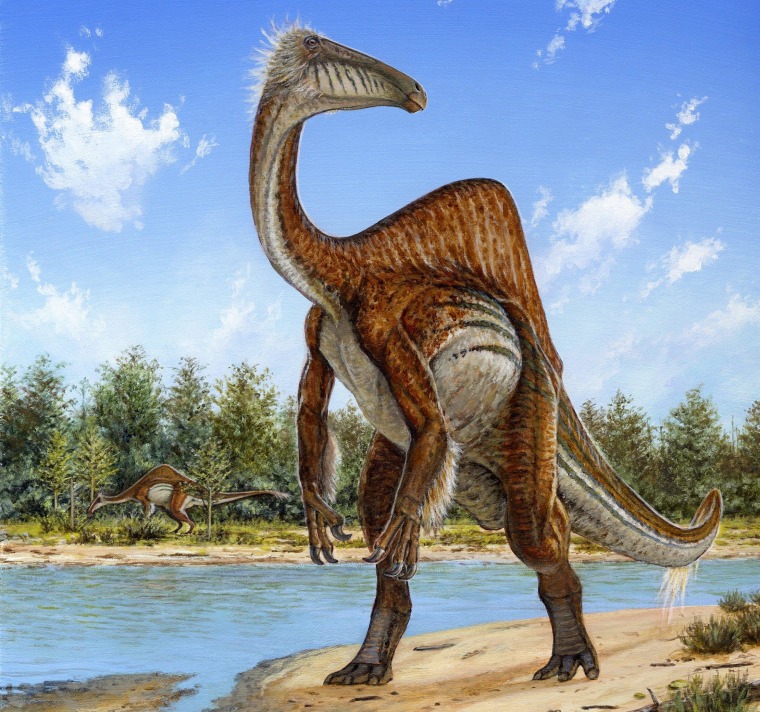This was a great year for dinosaurs. Dreadnoughtus, "Jar Jar Binks," and a swimming Spinosaurus all made headlines — and 2015 could hold even more surprises.
It wasn't always like this. From 1984 to 1994, there were about 15 new dinosaur species named per year. This year, nearly one species was discovered every week.
"We're absolutely in a golden age of dinosaur discovery," David Evans, who oversees dinosaur research at the Royal Ontario Museum, told NBC News. "It is probably a better time to be a dinosaur paleontologist now than any other time in the last century."
The 'Jurassic Park' effect
When it comes to finding dinosaurs in the dirt, paleontologists are using the same tools that they were 30 years ago. Satellite images might give them a better view of dig sites, but for the most part the process has not changed much.
So why are there so many dinosaur discoveries these days? More people are looking for them. Evans estimates that the number of dinosaur paleontologists has more than quadrupled in the last 30 years.
Every paleontologist interviewed for this story pointed to one catalyst for the paleontology boom: Steven Spielberg's 1993 blockbuster "Jurassic Park."
"It put the most lifelike, scientifically accurate dinosaurs ever on the big screen," Evans said. "That helped the public moved beyond the classical view of dinosaurs as slow, dim-twitted creatures."
Famed Montana State University paleontologist Jack Horner admits he has a special affection for the film. He served as scientific adviser for the original "Jurassic Park" and was the inspiration for Dr. Alan Grant, the movie's protagonist. He also consulted on the upcoming "Jurassic World" starring Chris Pratt.
"'Jurassic Park' attracted an incredible number of people to the field," Horner told NBC News. "I'm hoping that we put together something cool with 'Jurassic World' that people will really like and get more children interested in paleontology."
Increased interest led to increased paleontology budgets for museums and universities, Evans said. That has made a big difference in places like China and Argentina, relatively unexplored areas where a new generation of paleontologists has unearthed most of the recent headline-grabbing discoveries.
"The number of dinosaur researchers is much higher now than in the '90s," Thomas Holtz, a vertebrate paleontologist at the University of Maryland, told NBC News. "Anytime you are exploring a region and a slice of time that hasn't been sampled before, chances are that everything you are finding is new."
2014 and beyond
Some of the biggest discoveries of the year were not new species. Instead, they were more complete fossils of dinosaurs the scientific community knew very little about.
Take Spinosaurus, a massive carnivore that was even bigger than Tyrannosaurus rex. While its teeth indicated it ate fish, scientists were divided on whether it roamed the land and water looking for prey.
This year, the matter was settled. A new paper showed that the dinosaur's unique body structure — tiny hind limbs, dense bones, crocodile-like receptors in its snout — was best suited for the water and caused it to waddle on land.
"That was probably the most significant find of the year," Horner said.
There were other big discoveries in 2014. Dreadnoughtus fossils discovered in Argentina belonged to a creature that measured 85 feet (26 meters) long and weighed about 65 tons (59 metric tons), or about as much as a dozen elephants.
Then there was Deinocheirus mirificus, a goofy-looking dinosaur that has been compared to Jar Jar Binks from the "Star Wars" prequels. Nearly 50 years ago, scientists discovered a giant pair of claws they thought came from a fearsome predator. Fossils discovered recently painted a different picture: an awkward looking creature with a giant hump, no teeth and sporadic feathers.

While the tools used for finding dinosaur fossils have not changed much over the years, the technology used to analyze them has evolved tremendously. Today, scientists can use CT scanners, 3-D printers and powerful simulation software to gain insight into how dinosaurs moved and lived without having to damage rare fossils.
More fossils means a more complete picture of dinosaur populations, from adolescents to old-timers. Paired with new technology, the hope is that paleontologists can gain insight into dinosaur behavior and answer questions like whether early dinosaur ancestors had feathers or not.
"We're finding more species and we're able to do more with them once we find them," Holtz said. "It turns out that dinosaur diversity is even greater than we once thought."